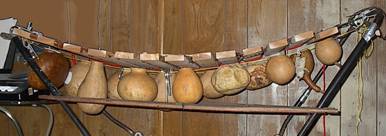Box resonators
Xylophone

Here the gourd provides the resonator and the structure on which the bars sit. This instrument would lend itself to the animal shapes found in Chinese xylophones.
If you don't need a lot of range, the xylophone is a good candidate for a gourd instrument. The bars are tuned by cutting an arch in the underside, a job that is easy with a band saw.
Primitive Banjo
Gourd banjos are common, but the tensioning here is not. It combines a
typical Native American-style rawhide head with the Mali weave used to tune
djembes. This gives excellent control over the tension on the
head, both while stretching and forever afterward. It allowed me to stretch
the head tight while it was drying and then release a little bit of tension
when the head started to get too tight. I put sound holes in the gourd to make it louder.
Bluegrass banjo players usually put a "resonator" behind the rim,
making a chamber between the head and resonator that amplifies the sound and
throws it forward through open space around the edge. Putting holes in the
gourd allows it to act more like this bluegrass setup. (Although, the banjo is
not for bluegrass; I've only heard old-timey players play fretless banjos.) This banjo has no manufactured
parts; everything came to me straight from nature: The wood is from trees in
my yard; The head was a road-kill; The strings are from
sheep intestines; The nut is bone from a
road-kill, stuck down with hide glue (made from the same road-kill); A piece of bark-tanned
leather protects the head where the strings bend over it; I used bees wax to
protect the gourd from moisture when the head was wet; I also rubbed the strings
and some of the wood with a pecan to oil them; The pattern on the neck
is burned; There are two strawberry
stains on the head to help locate the bridge. When the banjo was ready
to go to its new owner, we smudged it with sage. In making this
instrument, I learned not to put a lot of tension on a wet head unless the
gourd was protected from absorbing water. Once it gets wet, it can deform
under the pressure that stretches the head. 

Helmholtz resonators

